Mercedosaurus Rex at Indianapolic Park
Part 13: Practice during the 1994 'Month of May'
Author
- Henri Greuter
Date
- December 4, 2009; with September 25, 2014 additions
Related articles
- March-Alfa Romeo 90CA - Fiasco Italo-Brittanico, by Henri Greuter
- March-Porsche 90P - The last oddball at the Indianapolis Motor Speedway, by Henri Greuter
- Penske-Mercedes PC23-500I - Mercedosaurus Rex at Indianapolic Park, by Henri Greuter
- Introduction
- Part 1: Penske Racing at Indianapolis - new standards
- Part 2: Ilmor Engineering at Indianapolis
- Part 3: Mercedes, Benz and Mercedes-Benz at Indianapolis up until 1993
- Part 4: Equivalency formulas - waiting for things to go wrong
- Part 5: Stock blocks - keeping them rolling and promoting 'Born in the USA' technology
- Part 6: Indianapolis 1991 - Chevy And Rich Team owners
- Part 7: The Speedway narrowed, its speeds lowered
- Part 8: The forerunner
- Part 9: Pre-May '94 plans
- Part 10: Penske PC23 - a home for the engine
- Part 11: The 1994 Indycar season until mid-April
- Part 12: The unfair advantage and when others have it
- Part 14: Other bespoke-design 209s
- Part 15: From the last weekend of May '94 to the end of the season
- Part 16: Could the Mercedes Benz 500I have been stopped in time?
- Part 17: Creating an extinct species without it being forbidden, initially at least
- Part 18: The 1995 '500' - Did the Mercedosaurus bite its masters after all?
- Part 19: A possible twist of fate for Rahal-Hogan and Penske as a legacy of the 500I
- Part 20: Re-evaluation of our verdict
- Part 21: PC23's further active career after 1994
- Part 22: USAC’s points of views and some answers
- Part 23: The loose ends that didn’t fit in anywhere else and the epilogue
- Part 24: "Plan your work; work your plan" - Chuck Sprague on the PC23
- Appendix 1: Specifications
- Appendix 2: Car and driver appearances and performances during the Month of May 1994
- Appendix 3: Chassis, entry, practice and race numbers in 1994
- Appendix 4: PC23's 1994 results sans Mercedes Benz 500I
- Appendix 5: PC23's 1995-'96 results sans Mercedes Benz 500I
- Appendix 6: A reflection on the PC23 chassis used by Team Penske in 1994
- Appendix 7: A review of Beast by Jade Gurss
Who?Emerson Fittipaldi What?Penske-Mercedes PC23 Where?Indianapolis When?1994 Indianapolis 500, Carb Day (May 26, 1994) |
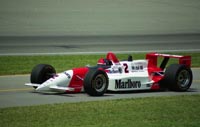 |
Why?
The Indianapolis Motor Speedway opened for practice sessions on May 7. By then, the official entry list did state that the Penske cars numbered 2, 2T, 3, 3T, 31 and 31T were Penske-Mercedes Benz cars. The Indianapolis Motor Speedway Media Fact book also listed this info, as well as a few details about the Mercedes engine in the engine section of the booklet. That said, few significant details were provided about the engine other than the fact that it was lighter but higher than the 265D, was more powerful and having more torque.
The Marlboro Racing 1994 guide (a.k.a. the Team Penske press kit) also failed to give any details about the Mercedes engine and stated that the '94 car used a quadcam engine. It did however include two cutaway drawings (made by Tony Matthews) of the car with a Mercedes engine.
There was a Mercedes press kit but the technical data sheet about the engine gave not a single detail of importance other than the weight, length, height and width of the engine. Therefore with respect to details, the engine remained a mystery for the media and public.
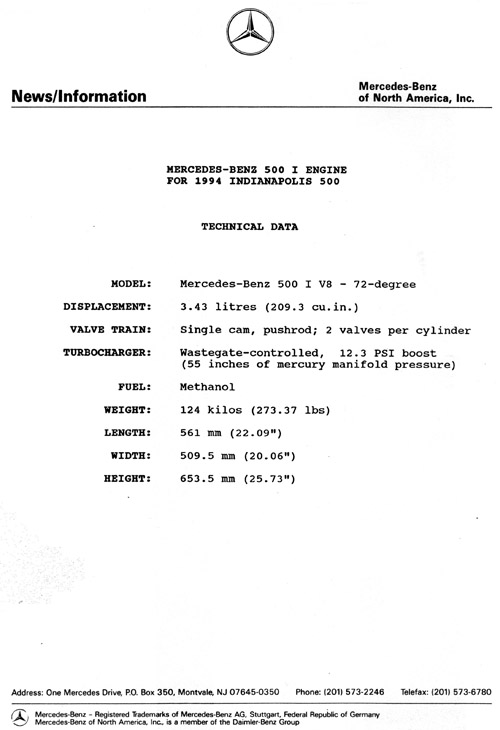
This was all the technical information about the engine provided by the Mercedes-Benz press kit released at Indianapolis. Even the fact the engine used methanol (as every other Indycar engine!) was used to tell at least something and fill up the page…
Surprisingly, although the Mercedes kit gave a lot of attention to the history of Mercedes at Indianapolis, the company made no use of the availability of two drivers who once used Mercedes hardware at the Speedway and were still alive: Duke Nalon (1947) and Danny Kladis (1957).
The Penske PC23 cars had changed a bit in appearance compared with their first races. The higher engine required a raised engine cover that was less streamlined than the regular version. The hump was remodelled to create something of a fin like the one introduced at Phoenix but the fin was much smaller than the one used on the Ilmor/D versions of the car. The technical committee at the Speedway were not entirely satisfied with the initial size of the fins when the cars were presented for scrutineering. They demanded the fins be shortened so that they did not extend beyond the rear axle, so some 6 inches had to be cut off.
Other than using the stronger gearbox, the USAC (or Indianapolis) version of the Penske PC23 wasn't necessarily that much different than the regular CART version.
Rain made any driving at the Speedway impossible on May 7 so it was the next day when Paul Tracy was the first of the three assigned drivers who turned a wheel at the Speedway in a Mercedes-engined car for the first time since 1948 and since 1923 if it came to a factory-supported effort. Fittipaldi also debuted his primary car at the Speedway that day, Tracy drove no less than three different cars: his primary, Unser's primary and a backup car, the one numbered 3T. There were no shocking speeds and times that day.
Meanwhile Al Unser Jr was busy testing a car at the Michigan Speedway that day, hence why Tracy drove Unser's primary car.
Team consultant Rick Mears told that this test at Michigan was because "We're working on reliability". Asked about it, Mears told that more tests at Michigan could be possible, depending on how things went at Michigan and that for the time being only Unser Jr would be testing there.
This Michigan test on May 8th however was a significant one. On that particular day the 500I survived its first test over a full 500 miles distance (520 miles in fact) under the guidance of Grant Newbury. Roger Penske told about this test:
"We run what we call a 'probe test,' That's where you run something harder than you have to run it in a race. We've run the new engine in probe testing many times over 400 miles. When Junior ran those 520 miles at Michigan with no yellows--you fill it up with fuel and run full tanks down to empty and just keep doing that until you finish it--that's pretty tough on the motor, and it came through it perfectly."
Emerson Fittipaldi had not been involved with the tests of the Mercedes-powered cars and Sunday 8 May had been the second time he drove the car. In a press conference held that Sunday he told the audience that it was an impressive engine and:
"It has a different torque, a different acceleration than a regular engine. There are a lot of different procedures you have to go through to adapt yourself."
One of the cars ended up second fastest on the following two days, Fittipaldi in #2 on Monday 9th, Tracy in #3 on Tuesday 10th. Wednesday May 11 was the first occasion when a Penske-Merc was fastest of the day, courtesy of Unser Jr. Unser stated that the pole for a Penske-Merc wasn't a forgone conclusion yet since the drivers were still working on making the car handle properly and get it quick through the corners. Perhaps the best indication of the difficulties that the Penske drivers were facing may be this statement by Unser: "We're still fighting the car for handling".
Were they really? The accusations about the Penskes sandbagging were numerous.
Nigel Mansell told the press that he thought the Penskes were using only 50 inches of boost in order to have something left for Saturday when the pole was to be contested.
And if they were indeed sandbagging, it was for good reasons. USAC had the right to change the rules instantly if they felt such was necessary for whatever reason. If the Penskes were flying around at over 230mph while the others couldn't break that barrier, then USAC could, for example, reduce turbo boost in order to slow down the Penskes. So it was in the team's own interest not to go too fast and avoid goading USAC into sudden rule changes.
But it was the other way around as well. The team was concerned about keeping an eye on the speeds to ensure that USAC would not hit the effort with a sudden rule change should the car prove to be too fast indeed once the handling was sorted out. So the team checked if USAC had given them pop-off valves that enabled the 55 Inch boost. Nigel Beresford told about that in the following manner:
"Roger was conscious that USAC was watching us and could somehow try to penalize us for being too quick once we got the cars sorted out. To that end he personally oversaw our popoff valves – he personally told us which valve to run (each driver got a primary and a spare from the organizers) and checked that we were getting the allowed 55."
Unbeknown to many, the Penske team had more difficulties to cope with then they showed they had. Among the issues was a gearbox problem. Nigel Beresford recalled:
"Torque was transferred into the box via a bevel gear which was on a common shaft with the drop gear. This assembly was held together by a bolt through its axis. This bolt kept failing. In the end Mario Illien himself redesigned the bolt in the paddock in Indy and we rushed to get them made – we had no more problems after that."
There was, however one problem that Mario Illien couldn't do anything about. The car was indeed very fast on the straight but the PC23 chassis had not been modified extensively to enhance cornering and increase corner speeds. As a result, the cars were not handling very well in the corners. All drivers had difficulties with the car. The primary problem was power understeer.
Nigel Beresford explained it as follows:
"Nobody was really at ease with the car. (…) The biggest problem at Indy was power understeer coming off the turns, because the engine made so much torque I think it made the car change its centre of pressure as it squatted coming off the turns. This was a problem all month long, and when people said that we were sandbagging I thought to myself that they didn't know the half of it. Nonetheless by the use of the larger stagger tyre and working on the setup (aero balance, weight distribution, springs & ARBs) we were able to get the cars fairly decent."
If the handling of the cars was compromised because of the rear fin being shortened, Beresford felt that:
"In hindsight this probably wasn't a bad thing, since the fin would have a tendency to shift the centre of pressure of the car rearwards, inducing understeer."
In his book Quicksilver Century Karl Ludvigsen mentioned another handling problem that the car had difficulties coping with. After hurtling down the straights with speeds of over 240mph the drivers had to slow down for the corners and this unsettled the chassis. Ludvigsen listed that the cars were cornering at 217mph, a bit slower than the best of the opposition was capable of. There simply had not been enough time in order to eke more performance out of the chassis to better use all the power it had.
Reading this description of unsettling the chassis, my initial thought was that this could be caused by the loss of downforce once the cars slowed down. The irony of the situation is that the car generated more downforce on the straight than needed and when slowing down for the turn it could use the extra downforce it lost because of slowing down.
Discussing the described phenomena as well as how I felt what was going on with Nigel Beresford, Nigel took the efforts to explain what was the case.
"The pushrod-engined car was not flat in the turns (except maybe in qualifying) because it was going too fast on the straights to allow the drivers to run flat through the corners. The car didn't handle particularly well at Indy, but a large part of that was because the drivers were having to decelerate for the entry to 1 and 3 and then accelerate on the exits. This caused pitch changes in the car which changed the aero balance, plus there was also the torque effect from the stagger. I can't remember exactly but I expect we were running the larger of the two staggers offered by Goodyear (we usually did, because understeer was typically the problem). This helps the car to turn when on throttle but the disadvantage of this is that variations in the applied engine torque (i.e. from lifting) create a variation in the yawing torque created by the tyre stagger, which also upsets the balance. The bottom line is that our drivers may have had a big power advantage, but exploiting it took a change of driving technique. It wasn't a case of sitting there, being brave and holding the throttle wide open. So, with regard to the aero portion, no I don't think there was any issue with lack of downforce - more a case the consistency of aero balance."
Addition made in September 2014: In his book Inspired to design, Nigel Bennett explained that because of the larger differences between top speed and corner entry speed as well as during acceleration out of the corners there was a larger shift of mass going through the car which made it less stable. In addition to that, there were the pitch changes during acceleration that combined with the higher C of G had major effects on the balance of the car. Bennett also stated that when many years later he asked both Tracy and Unser Jr about the handling difficulties of 1994 they told him that generally it was fine but that the main problems were caused by the larger speed differences between the straights and corners.
Thursday May 12 saw Fittipaldi set the fastest time of the month and cracking the 230mph barrier. He was timed at 230.43 and caught with a top speed of 245mph. Tracy barely missed the barrier with a high 229.9, Unser remained stuck at 227.4.
Mentioning the top speed of 245, the cars were geared in order to reach a maximum of 252mph.
Despite the fact that he had done so little running with the PC23-500I in Pre-Indianapolis test sessions, it didn't appear as if it was any setback to Emerson.
Fittipaldi told the media that the wind had helped his speeds and that he came much faster out of Turn 4. He also told that the handling of the cars this day was much better than two days earlier. His comment on the suggested sandbagging by the Penske team was:
"No way, we're not sandbagging. I don't see the advantage. People don't realize that there is no advantage to it."

Roger Penske, busy at work, in control of the situation. He isn't mentioned here as often as his partner Mario Illien but the man standing next to Roger is Paul Morgan, indeed, the mor in Ilmor. (photo HG)
One day later came the first sign of a mishap within the team. Paul Tracy had a crash in Turn 3 and was injured enough to be forced to stay at Methodist Hospital overnight.
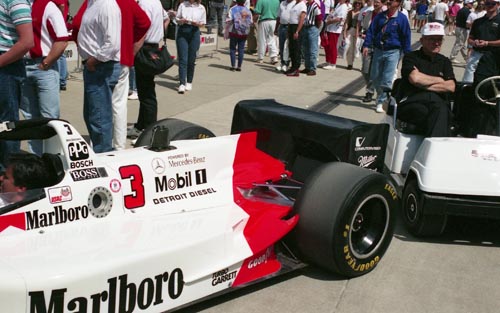
This is the best picture I have of the primary car of Paul Tracy, the #3… (photo HG)

… before it came back 'on the hook', not to be seen again anymore that month… (photo HG)
This spoiled at least one of Team Penske's intimidating plans: the all Team Penske front row. The reason for the accident was simple: Paul had entered Turn 3 some 15 to 20mph faster then he had done up until then before losing it. This was the only incident in which a Penske-Merc was involved all month, but it surely came at a very inconvenient time. Prior to his accident Paul had set a time (giving an 228.693 average) that at the end of the day turned out to be second fastest. Fittipaldi had been the fastest again and was by now tipped to be the most likely pole winner.
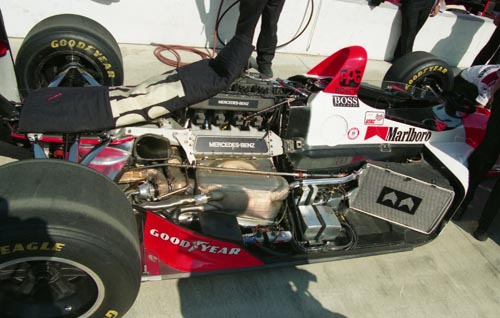
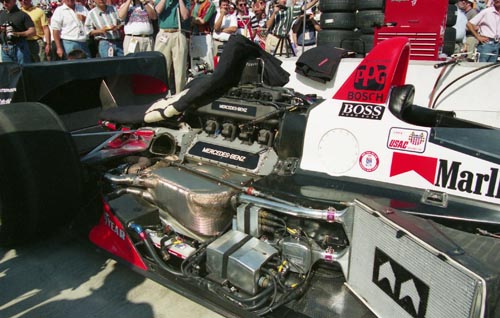
Pictured on 'Fast Friday' May 13, the engine installation and internals of the right sidepod in the PC23. This is Fittipaldi's car. The blanket on the engine was standard. Whenever an engine cover of a Penske-Merc had to be raised, a blanket was thrown over the engine in order to hide as much as possible. (photo HG)

This was what could be seen if you couldn't get on the pitlane. (photo HG)
Rain played its part on Pole Day.
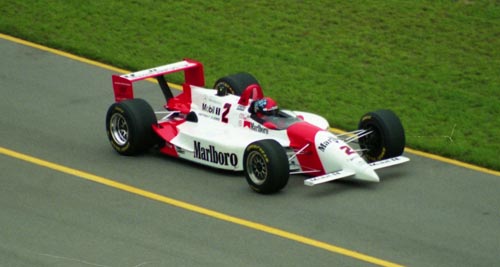
Emerson Fittipaldi during one of the practice sessions held on pole day. (photo HG)
Al Unser Jr had drawn an early number, and he was the only Penske driver able to qualify before the rain came, taking the provisional pole. His run was a bit bizarre, starting with a fairly poor 225.7, jumping to 228.3, 228.5 and closing with his fastest lap of them all: 229.4mph. Even in practice under near ideal conditions he had not been that fast yet. Some critics felt that this confirmed Team Penske had indeed being sandbagging up until now. Many of those 'paranoids' had forgotten that it was not unusual for Unser Jr to save his best for the moments it really mattered. During practice Al made sure he knew how to be fast over an entire lap but rarely showing such in practice. If it was 'sandbagging', it was the kind of sandbagging Al was known for.
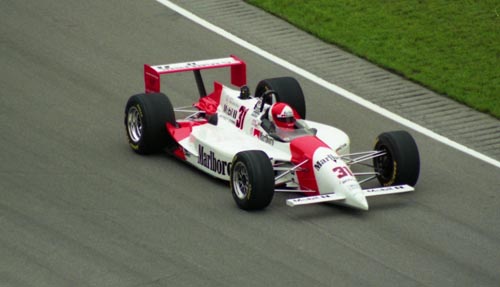
Al Unser Jr during his run that earned him pole position. (photo HG)
The bad weather prevented team mate Emerson Fittipaldi from getting his opportunity to qualify that day, although he remained eligible to qualify the next day as a 'first-day qualifier' and was expected by the team to steal the pole from Unser. Paul Tracy had only just been released from hospital and was not passed fit to run on Pole Day – he would have to be a second-day qualifier with no shot at the pole.
Al on temporary pole, Fittipaldi, the fastest driver in practice to qualify on the next opportunity. It was a curious reversal of the situation of 1990.
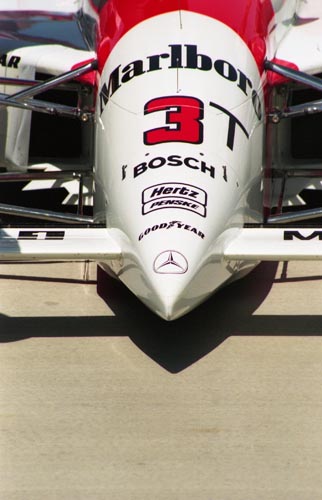
Pictured on May 15th, a car numbered 3T, on the pit lane, showing off the Three Pointed Star on the nose. The number indicated this could be the car that Paul Tracy would qualify. However, 3T was driven that day by Al Unser Jr while Paul qualified the 31T. (photo HG)
The following day saw Emerson Fittipaldi also qualify his car on the front row but 'only' third fastest. Conditions had worsened compared to the day before, making it impossible for Emerson to challenge Unser for the pole.
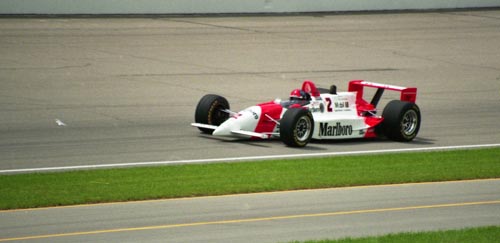
Emerson Fittipaldi was permitted to continue his qualifying attempt despite the debris on the track. That white spot is no negative imperfection but a plastic bag on the track. (photo HG)
Paul Tracy made the field on his second attempt after waiving off a first attempt in which his fastest lap was good for only 220.8mph. At the end of the day he had the 28th starting spot but was 16th fastest and safe. Tracy qualified the 31T car as his primary car 3 was too damaged for further use.

Paul Tracy on the second day of qualifying. The T behind the 31 on the side is barely visible. Since the official qualifying pictures of Paul are lacking the Ts I think this picture was taken either in a practice run before qualifying began or during the aborted first attempt. (photo HG)
During that first week of practice it had been primarily the intended race cars numbered #2, #3 and #31 that had seen service. And of the backups only 3T and 31T had made some laps before qualifying began, both cars less than 50 laps in total. It would have been logical to assume that Paul would take what could be considered 'his' backup, the #3T, but instead he got #31T, this despite the fact he had driven more laps in #3T than in #31T.
Nigel Beresford (Paul's engineer) explained that, although the backup cars carried T numbers to the primary numbers, Paul wasn't assigned a predetermined backup car. The eventually qualified cars went back to the shop in Reading PA, for re-painting while in the second week of practice the backup cars were to be used for sorting out the handling of the cars, the setups then being transferred onto the primary cars.
The sound of the Mercedes-Benz 500I was different to say the least. The Buick and Menard V6s were loud and bellowing, almost droning. Most of the various quadcam V8s that qualified for the race (Ford XBs and Ilmor 265Ds) were less droning and more screaming. The Honda V8 on the other hand sounded more droning, a bit like a Detroit stock block. The Mercedes V8 was far less loud than the pushrod V6s and came closer to the quadcam V8s but less high-pitched and less loud as well. Another strange aspect of its sound was that the engine, once at speed, also produced a kind of whistling, almost turbine-like scream.
Because of journalist duties at location I carried a little tape recorder with me on the two qualifying days and I made some sound recordings of the various engines. Although they are definitely not hi-fi recordings, here are some examples of the sound from the engines that tried to qualify on Saturday May 15. I sat at the top-deck level in Turn 1.
I added the other engines in order to prove that the Mercedes was indeed much less loud then the others.
- Cheever, Menard V6 (WMA file, 380k)
- Boesel, Cosworth XB (WMA file, 380k)
- Fernández, Ilmor/D (WMA file, 300k)
- Unser Jr, Mercedes Benz 500I (WMA file, 1.5M)
- Groff, Honda (WMA file, 380k)
On Sunday May 15th I was standing in the inside of Turn 1 and did some sound registrations again. Note how much louder the XB is over the 500I.
- Vasser, Cosworth XB (WMA file, 300k)
- Fittipaldi, Mercedes Benz 500I (WMA file, 260k)
During the second week of practise the three Penske drivers shared the 2T and 3T cars to add up the miles in order to gain more knowledge about their cars and sort them out for a suitable race day setup.

The radiator opening was tiny on the PC23, and have a look at the 'shark teeth' at the bottom of the sidepod. (photo HG)

The connecting tubing between plenum and turbo had been removed by these mechanics but they assured that nobody could have a look at the entry into the plenum. Covering up what could be covered up was the order of the day with Penske. (photo HG)
On all days from Monday May 16th to Thursday May 19th, Fittipaldi drove the 3T and was fastest of the day on all these days. A bit curious to notice that Emmo's primary car was numbered 2 but during this second week of practice he never got into the 2T.
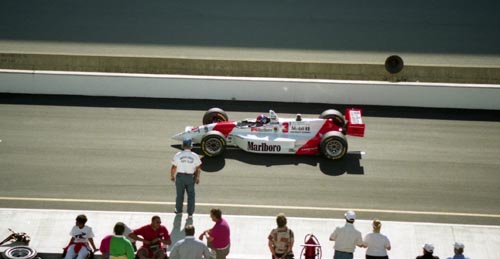
Heading back from yet another practice run back to the crew, seen from one of the hospitality suite balconies on Tuesday May 17th, Fittipaldi in 3T. (photo HG)

This one is out of focus since I had to hurry to make this shot in time before the wing was covered off again! Rear wings were often covered on cars parked on the pit lane. But I think that no other rear wing that I saw looked like providing so much downforce as the ones I saw on the Penskes. (photo HG)
Fittipaldi did not practice on Friday May 20th and driving duties in 3T were taken over by Tracy.
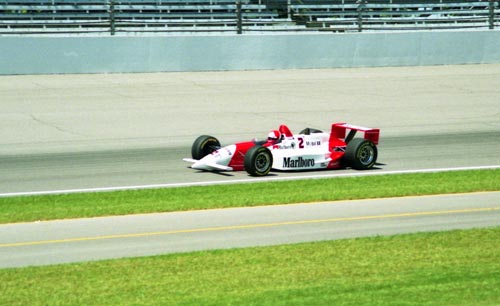
Al Unser Jr was the man who drove most laps in the 2T during the second week of practice. Here seen on Friday May 20th. (photo HG)

Car 3T once again but without Emerson in the cockpit! Paul Tracy had the car to his disposal on Friday 20th. (photo HG)
Tracy and Unser had shared driving duties in the 2T in the days before, but none of them made as many miles as their team mate Fittipaldi. In fact, no other driver entered that month made so many practice laps as Emerson.
It was Saturday May 21 before the three qualified race cars 2, 31 and 31T (to be renumbered 3 on race day) appeared at the track again.
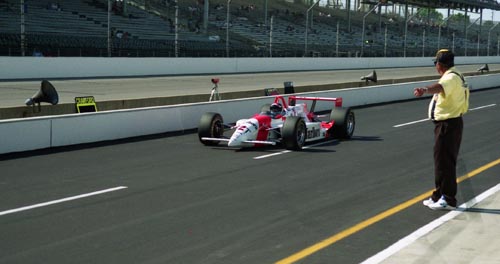
“This way son!” Paul Tracy getting back from a stint in the 2T another time. Paul also drove his qualified 31T, now numbered 3, while 2T was also used that day by Al Jr. (photo HG)
However, even though the Penske drivers were out and practising, they didn't mix it with the fastest drivers anymore. Tracy and Fittipaldi were 3rd and 4th fastest on Saturday. That Saturday was a busy day for the mechanics. Apart from their qualified cars, the drivers also took out the two available backup cars for laps, Trace and Unser shared the 2T, Fittipaldi was once again in the 3T. One day later, the crew had a 'piece-of-cake day' with only 3T being used for practice laps by (of course) Emerson and Al Jr.
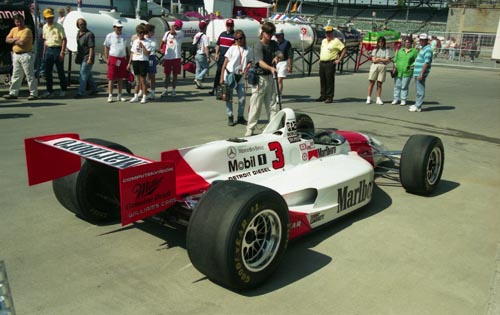
It's Sunday May 22nd, Bump Day at Indianapolis. The car originally entered as 31T, now renumbered #3 for race day was used for a photoshoot by ABC TV. The two men behind the car are ABC TV people who used a pole-mounted mini camera for making overhead shots of the car. The footage made was used in the race report when the Penske-Mercedes was introduced. (photo HG)

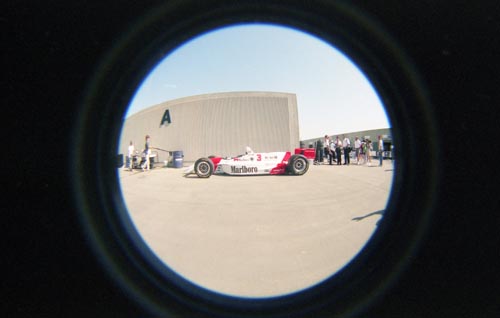


With the car already being used for creative photo shooting, I used the opportunity to do the same. (photos HG)
The three Mercedes-engined cars made up half of all qualified cars with a pushrod engine. The brand new Greenfield V8, fitted into a 1993 Lola and driven by Johnny Parsons didn't make the race. That Buick had left Indy was even more clear to see. Only a single car with a Buick-branded engine made the field. But that particular car was one that had gained respect at the Speedway. It was the Lola T92/01 chassis HU0010, the car that had won the pole in 1992 with Roberto Guerrero behind the wheel. Coincidentally, Guerrero was again driving the car in which he had set new track records that were still valid.
The other two pushrod engines in the field were the Team Menard entries driven by Scott Brayton and Eddie Cheever, powered by derivatives of the Buick, now developed by Team Menard themselves and also named Menard V6. Owner John Menard hadn't ordered new cars for 1994 and used the 1993 cars again. In 1993 these new cars had disappointed compared to the performances of the then new 1992-type cars in 1992. This year however the by now one-year old cars performed reasonably well but of course were left in the shade of the Mercedes 500I-powered cars.
But it was noticeable. Though USAC welcomed an input by pushrod engines, and with 1990 and 1992 being years with a third of the field powered by such engines, the decline was there to see. In 1992 there were 11 Buicks in the field, but by 1993 the total of Buicks and Menards combined was 8 and in 1994 the combined total of V6 engines stopped at 3.
Despite suggestions that USAC could come up with an emergency rule to slow down the Penskes, this didn't happen, and due to a string of circumstances USAC and the Speedway really couldn't afford to do anything against the rules for the pushrod anymore (more on this elsewhere on this site). Even so, several people involved in racing commented on the situation, like Derrick Walker, who stated:
"I don't think the rule was put in to create a prototype, and that's what Penske has done. Roger is the only guy on the pit lane who has the resources to develop a project like that. The rule is absolutely the dumbest thing we've got. The Penskes will be running a mile or two faster than the rest of us in the race. I know it's the first race for the Mercedes engine, but Roger wouldn't be putting all his eggs in it if he weren't sure of its reliability."
In the week before race Fittipaldi revealed to the press that the cars had a major problem with handling in the turns. The chassis had not been ideally suited for fast cornering and time had run out on spending much time to work on that. One quote by Fittipaldi I found in print was the following:
"It's very important, the handling. The engine is very good and the horsepower is there, but the power is good only if you can get it through the corners. There has been so much attention paid to the motor that now we must find the perfect chassis."
The Penskes had been by far the fastest things on the straight but their cornering speeds were not among the fastest speeds recorded. A trained eye could notice that the cars were less stable in the turns. It was almost as if the cars were modern day Novis: cars known for their straightline speed due to their power advantage, but slow in the corners. Now, were the Penske-Mercs to be as notoriously unlucky in the race as the legendary ill-fated brutes of the past?
Another thing seen in practice, the Penske-Mercs hadn't been way faster than everything else, in pure outright lap speed there had been cars close to them. For example: during practice Raul Boesel had been faster in average lap speed than Unser and Tracy ever managed to do. They were, however, fast in every circumstance and every day they were out.
Nevertheless, Unser and Fittipaldi in particular were hot favourites for victory. Based on the fact that repeat winners were rare, Unser seemed to have the odds in his favour while Fittipaldi was the defending winner! As long as they didn't break, who could stop them?
One of the faint hopes issued by several competitors was that the race would be fast and with hardly any yellows at all. If the brand new 500I engines were put under the strain of long periods of performing at the top of their capabilities they perhaps might break down or maybe run out of their allocated fuel amount. Besides that, Fittipaldi also revealed that it was easy to overrev the engine during quick departures from the pit lane after stops. If there were few yellows and the cars had to make stops under the green light too often this could be another risk for the reliability of the engines.
Not that the opposition had any reasons to have much faith in the Mercedes engines being unreliable. Despite being brand new, during the practice at the Speedway not a single engine failure had occurred at Team Penske. In the years of Ilmor-Chevies the team had always suffered at least one engine failure…
Another prize was won by the 500I. Mario Illien received the Annual Louis Schwitzer Award for engineering excellence and innovation in racing. It was difficult to ignore the impact of the Mercedes Benz 500I engine.

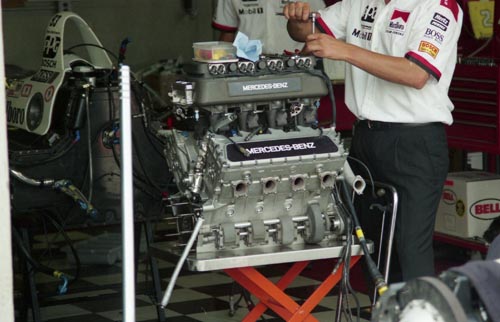
In the days between Bump Day and Carb Day there is little to do on the track itself. In the garages however there is still a lot of activity. The day after Bump day I was finally lucky to see some of the less careful Penske mechanics working in the open on two 500I engines. Once I was spotted trying to take pictures the doors were closed instantly… (photo HG)
Carburetion Day appeared to be nothing special. Mario Andretti was fastest while the Penske team had only third and tenth fastest speeds. But Team Penske had not shown its true colors yet, save on one occasion. Nigel Mansell, fourth fastest in the Carb Day session was following Fittipaldi briefly but Fittipaldi 'floored it' and shot away from Mansell's Lola-XB.
Once back in the pits Mansell again spoke out about the rules that permitted a team to spend millions of dollars to get an engine with so much more power than the opposition and that he didn't like the engine disparity at Indianapolis.
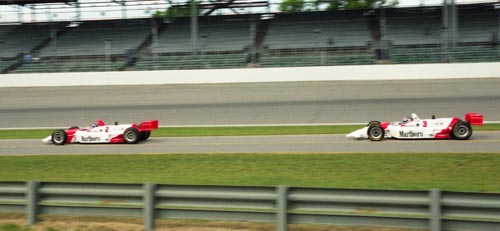
Fittipaldi and Tracy in the warm-up lane inside Turn 1, ready for practice on Carb Day. (photo HG)
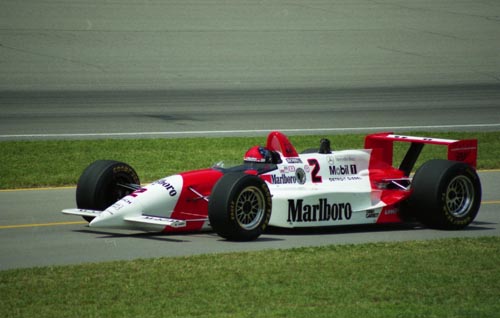
Emerson Fittipaldi on Carb Day. (photo HG)
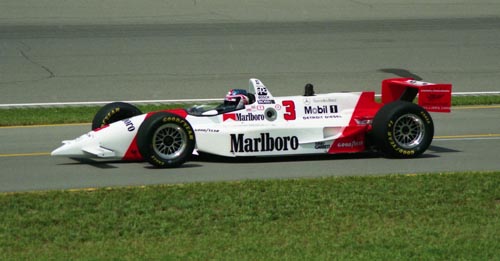
Paul Tracy on Carb Day. (photo HG)

Hi Al! (photo HG)
A little known fact about the Carb Day sessions is that Al Unser Jr had difficulties with dialing his car in and eventually got the help of Fittipaldi's engineer to make his car handle.
But unbeknown to their rivals, Team Penske was sweating bullets after Carburetion Day. During a teardown of one of the intended backup engines, it was discovered that it had been a fitted with faulty piston rings, a bad batch somehow having turned up at the factory. Some of those might have ended up in the brand new engines that were built up for the race. The confusion about what to do only increased since the suppliers of the rings initially made it known that there was no reason to change the rings. Then, right after the tests on Carburetion Day, the supplier made it known not to use the rings after all. Eventually the team decided against replacing the installed engines that had run well on Carb Day and stuck with the engines installed. But it still was a risk.
Roger Penske had been quoted as:
"We could come out of here with some pretty long faces come race day. But I'm proud of what we're trying to accomplish. I'm not sure we'll win the race but we've got a plan. That's where we want to be."
It could be a much closer matter than everyone outside the Penske Team ever realized because of these rings…
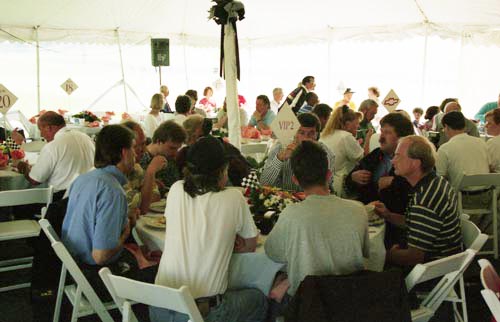
During the AARWBA breakfast held at the Speedway Grounds the day before the race the VIP 2 table was occupied by Mercedes Benz hotshots, including Norbert Haug (right under the Chevroled symbol). How worried was Norbert at this moment because of the knowledge regarding the piston rings? (photo HG)
